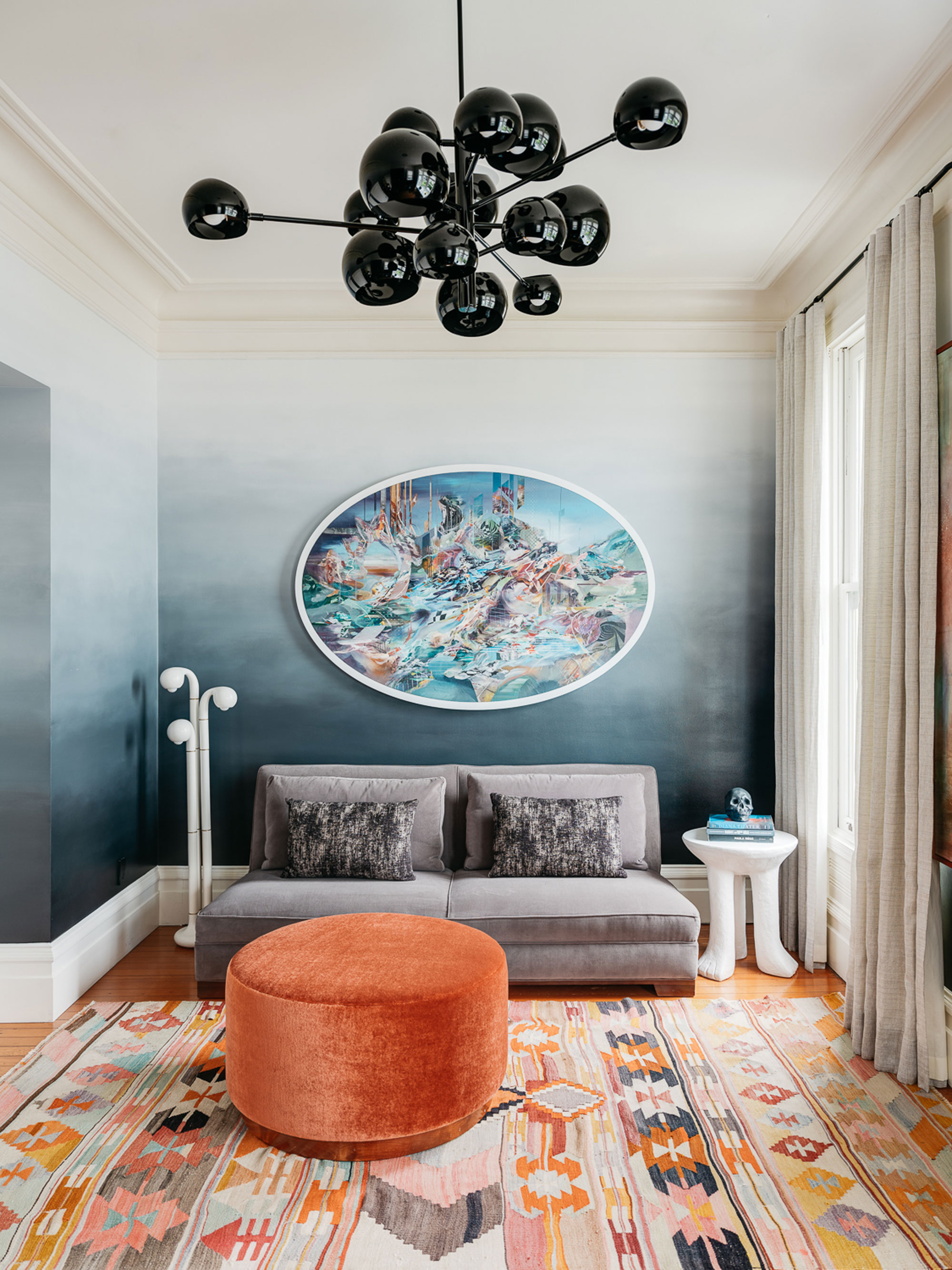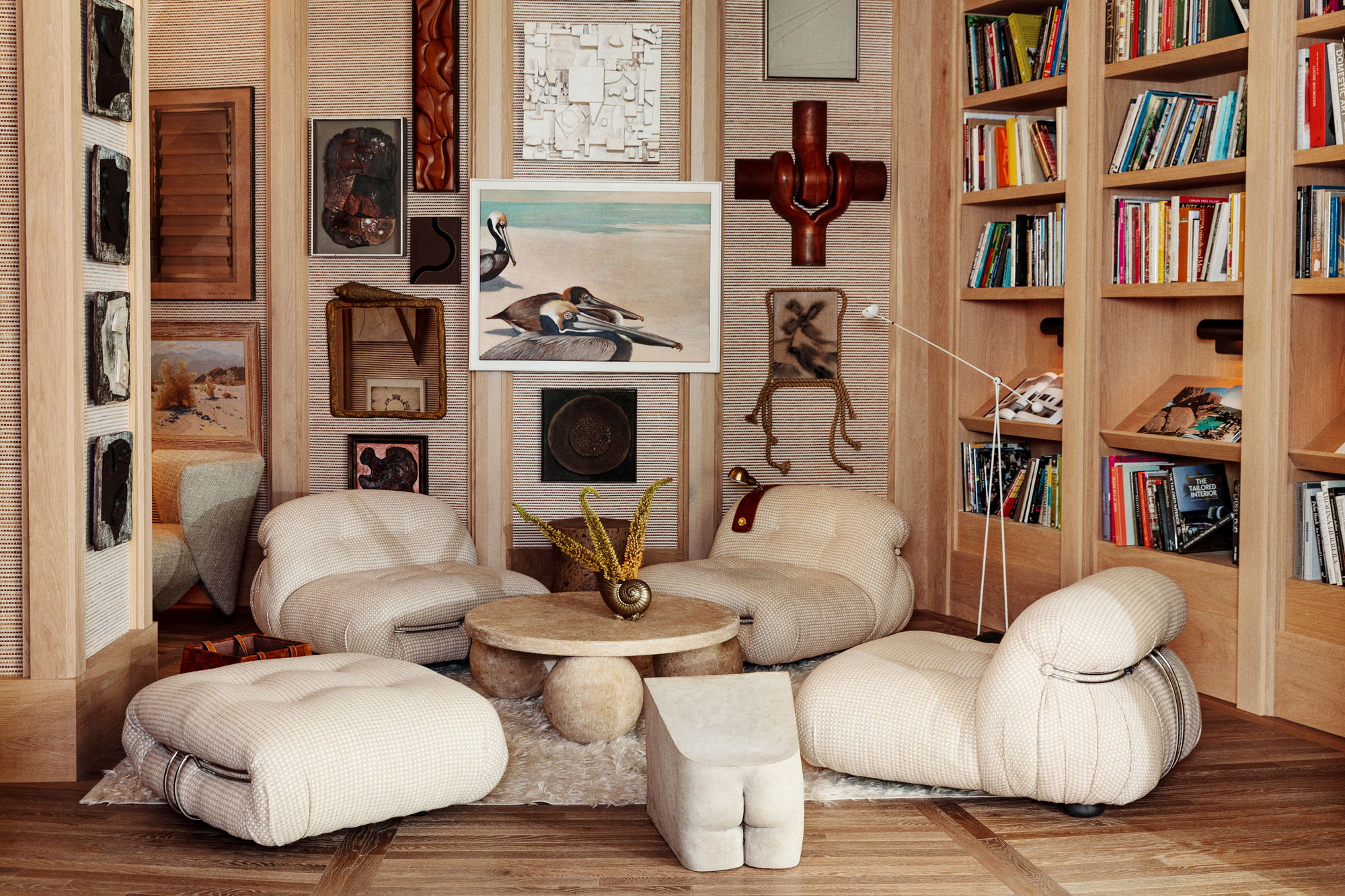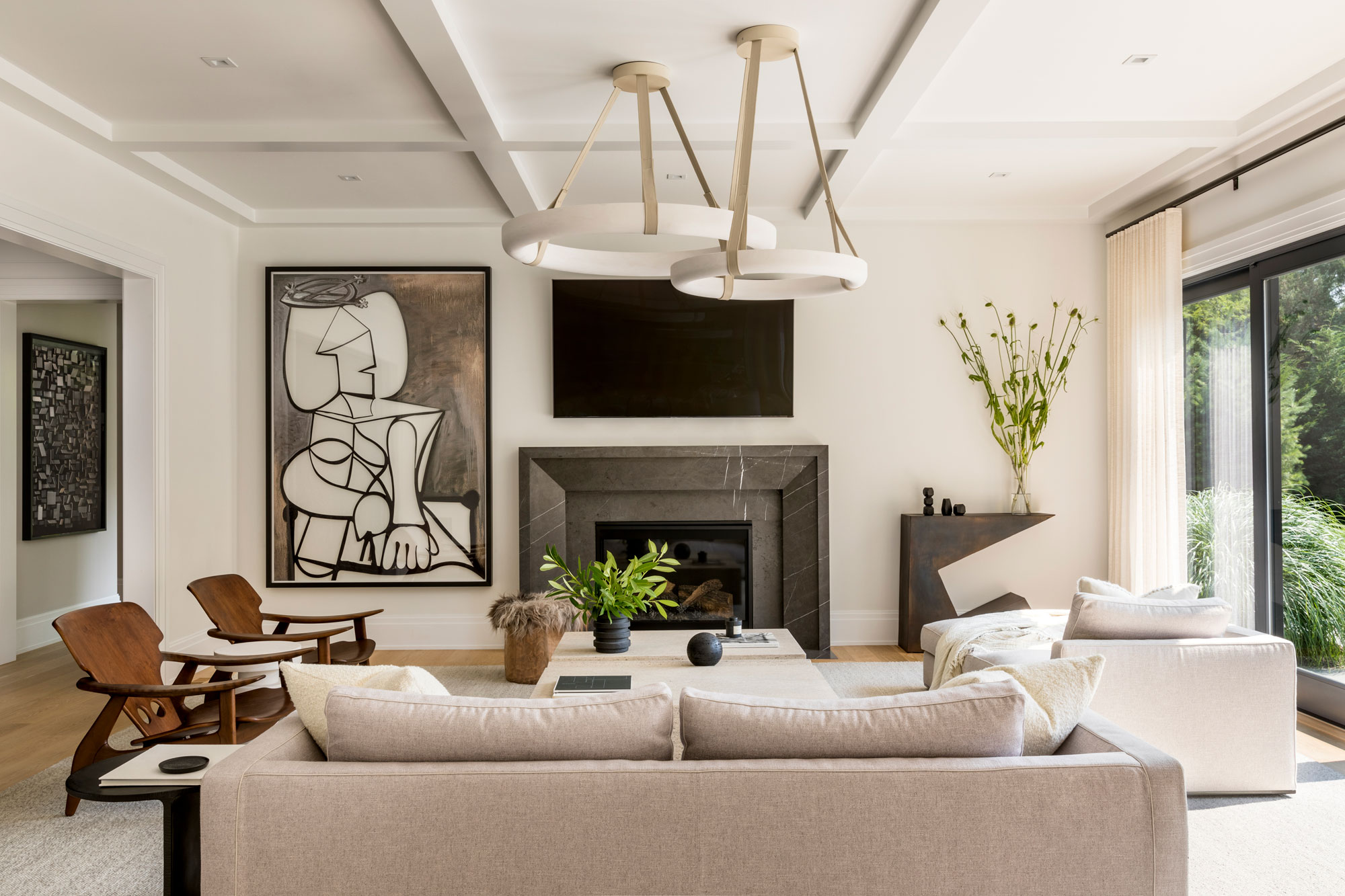How to display wall art in a living room – designers and stylists on the new ways to hang frames in your home
Some of our favorite designers are using fresh living room wall art ideas to elevate the way we display wall decor. Get their top tips for hanging artwork and the trends in framing and more


You often find that people choose their living room wall art ideas at the end of re-designing a space. But, really, choosing art should be high on your agenda, at the top of your list, in fact.
The right piece of art can, after all, help lead you to all the other elements you pick for your living room scheme. The color palette? Of course. Shapes and textures that define your design? Definitely. Art can provide a seed from which a whole interior design scheme can blossom.
But, the journey to finding the right art as part of your modern living room ideas is a personal one. Even if you share a penchant for a particular interior design style with a friend or neighbor, your taste in art can still be much removed. Interior designers often work more as guides for choosing art for a home than a dictator, and rightly so.
'We create a design intention for each project that captures the spirit of the interior,' explains interior designer Kenneth Brown, who has designed homes for a number of celebrity clients. 'Art is an added layer we guide the client through by exposing them to various artists.'
Displaying your art is a different story, however, and one that can be talked about in more general terms. With help from a few interior designers who know a thing or two about creatively showcasing beautiful artwork, take a look at these fresh ways to display your favorite pieces.
Designers explain their favorite new living room wall art ideas
There are certain design rules for hanging artwork it's wise not to ignore, but some of the most exciting examples of displaying art right now take the rulebook and throw it out the window. Artwork that might traditionally be seen as too big, or too small, is creating something a little bit unexpected, and special, when the positioning is just right.
In this gallery of living room art ideas, you might see some old favorites (of course, the gallery wall is sure to feature), but showcasing how designers are suggesting their clients bring their personality to the space successfully and in a contemporary way.
The Livingetc newsletters are your inside source for what’s shaping interiors now - and what’s next. Discover trend forecasts, smart style ideas, and curated shopping inspiration that brings design to life. Subscribe today and stay ahead of the curve.
1. Layer artwork on shelving

Small-scale artworks are an invaluable part of your styling armory, especially for open living room shelving. There's a sense around art that it's sacred and should be given room to take center stage, but it really doesn't have to put on such a pedestal. Use it to create a backdrop that you can layer other objects in front of.
'The key is to style the art as part of a vignette with other objects,' says Kerrie-Ann Jones, an interior stylist based in Australia and founder of online styling course The Stylist Lab. 'For example, have the artwork styled with a vase and candle clustered together. It creates a focal point on the shelf and is a beautiful visual story.'
'It's also important to consider a color palette with the books, objects and art styled on the shelf, so they don't clash.'
This neutral design by Kerrie-Ann is also an exercise in the power of negative space. There's a boldness in knowing when enough is enough, being confident enough to not fill every shelf when styling a space.
2. Scale up in a small living room

Size matters when it comes to specifying the right art for your living room, yet many modern designers don't necessarily pick art that's sized for the room in the traditional way. 'I think art curating is very independent and detached from the actual design, but it needs to be proportioned,' says Los Angeles-based designer Davide Casaroli. 'Sometimes I intentionally scale the art based on the size of the room, sometimes I undersize it based on the importance of the art piece.'
'The only rule that I apply is not to end up with a USPS mail stamp on a large wall,' he adds.
This applies to small living room ideas too. Canadian interior designer Sabrina Albanese suggests experimenting with scale, avoiding apologetically sized pieces. 'I naturally gravitate to large artwork in a smaller room,' she explains, 'and I am particularly looking for large-scale subject matter. A small or busy print can make the room appear even smaller.'
3. Style art with high contrast

Displaying art isn't just about the way it's framed or hung, but also the wall it's presented on. How does the color of the art play against the paint colors on the wall? There's a friction between a piece of art becoming a feature of a room, or rather providing a background texture. Sometimes, high contrast can still do both.
While these pieces demand attention, they also play a role in the larger picture of this black and white living room. 'There's a strong dialogue between the dining room and the art pieces,' Davide explains. 'The arch is somehow dividing the acrylic paintings but it's also exciting curiosity about their full story. The black accents became a grid where the white stucco and the abundant natural light are framed with. The key is the balance between the whites and the dark features in the space.
While these pieces demand attention, they also play a role in the larger picture. 'There's a strong dialogue between the dining room and the art pieces,' Davide explains. 'The arch is somehow dividing the acrylic paintings but it's also exciting curiosity about their full story. The black accents became a grid where the white stucco and the abundant natural light are framed with. The key is the balance between the whites and the dark features in the space.'
4. Or go tone-on-tone, but with texture

On the flip side, art doesn't have to stand out at all, and sometimes introducing artwork that does more to add texture is the right choice.
'We encourage our clients to consider mixing different mediums in one room, so its not all one note,' suggests interior designer Kenneth Brown of California and Louisiana-based Kenneth Brown Interiors. 'This neutral living room had a strong colorful piece, so the textured piece over the fireplace is about shade, shadow and texture and lack of color.'
5. Disrupt your scheme with circular wall art

There's something oddly engaging about artwork that's not your standard square or rectangle, but none more than circular art. It's become a shortcut for contemporary designers to bring a luxuriousness to a room scheme - because it's more unusual to see, it feels bespoke and high-end.
It also helps to break up the linear nature of a luxury living room. 'Orbs, circles, and ovals add a nice dimension to otherwise square rooms,' says Holly A Kopman, of Holly A Kopman Interior Design. 'They soften edges and add an unexpected and contrasting shape.'
7. Master the modern gallery wall

The gallery wall obsession feels like a moment in time that, some might say, has now passed. But, there's a reason why they're so adored, and why you should still consider one for your living room. So what's the key to making them work in the here and now?
'Gallery walls are very important as they can tell an entire story of the person that lives in the home,' says interior designer Kenneth Brown, and that's at the heart of what a successful gallery wall should do. They should be collections, curated and changing, that tell a story. That might mean that gallery wall ideas aren't limited to 'flat' art - frames and canvases - but also other interesting artifacts you've collected over time - take this modern art display by Kelly Wearstler as an example. The fall of the gallery wall came, in this writer's opinion, from the idea that you could bulk buy wall art in batches for an instant but ultimately bland and impersonal art display.
Go big with your gallery wall ideas, too. Modern designers are avoiding small clusters of art for supersized wall decor. Cover your walls from top to base, sometimes even layering behind furniture. Gallery walls with huge pieces of art also give a fresh twist on the idea.
7. Create balance, not symmetry

Symmetry is a useful tool for decorating your home, because it feels so logical. Symmetrical art layouts in a living room are tried-and-trusted, but that can make them feel a little... basic. Doing something unexpected and off-center might be just the disruptive force a space needs to elevate the design.
Getting this look right isn't about symmetry, but it is about balance. Take this design by Jessica Gertsen Interiors as an example. 'This living room has a contoured and sculptural element to it,' explains principal designer Jessica Gertsen. 'The Jose Davila art piece on the left side of the fireplace was selected to balance the sculptural console on the right side, and vice versa.'
There's something about going asymmetric with an art display that creates movement in the room, preventing the eye from resting on the comfortability of symmetry for too long.
8. Remember art doesn't just have to be for walls

It's important to think of art not just as a space-filler on the walls, but as contributing something to your interiors that has something to say. Art can set the tone as much as color or design style, if you let it.
'This space, for example, reflects the homeowner, who wanted a punch of color and excitement to capture their entertainment style,' says its interior designer Kenneth Brown. And it doesn't just stop at the walls.
Usually a reserve of actual art galleries, plinths are making a transition into the home too. They may just seem like taller side tables, but they're not designed as functional furniture in the same way. Use one to bring art into your living room in an elevated way, quite literally.
9. Mix eclectic frame styles

Whether you're designing a gallery wall or just framing different artworks in the same room, embrace the eclecticism of varying frame materials and styles.
'I prefer slim, simple box frames in either black, white or oak timber for large artworks,' says interior stylist Kerrie Ann Jones. They are modern and let the art be the focus.'
'However, sometimes it's fun to use an oversized chunky frame for small artworks to make the art more of a statement piece,' she adds.
A little more consideration needs to be given to mixing frames in a gallery wall so that your composition works. 'The key to making mixed frames work together is having consistency with how they are arranged on the wall,' Kerrie-Ann explains. 'Arranging the art in a grid-like pattern with the gap between each piece of art the same, around 1.5 to 2 inches, creates cohesion among the mix.'

Luke Arthur Wells is a freelance design writer, award-winning interiors blogger and stylist, known for neutral, textural spaces with a luxury twist. He's worked with some of the UK's top design brands, counting the likes of Tom Dixon Studio as regular collaborators and his work has been featured in print and online in publications ranging from Domino Magazine to The Sunday Times. He's a hands-on type of interiors expert too, contributing practical renovation advice and DIY tutorials to a number of magazines, as well as to his own readers and followers via his blog and social media. He might currently be renovating a small Victorian house in England, but he dreams of light, spacious, neutral homes on the West Coast.